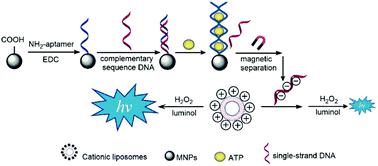Our official English website, www.x-mol.net, welcomes your feedback! (Note: you will need to create a separate account there.)
Cationic liposome-triggered luminol chemiluminescence reaction and its applications.
Analyst ( IF 4.2 ) Pub Date : 2020-05-11 , DOI: 10.1039/d0an00632g Yongxin Huang 1 , Ningning Yue , Aiping Fan
Analyst ( IF 4.2 ) Pub Date : 2020-05-11 , DOI: 10.1039/d0an00632g Yongxin Huang 1 , Ningning Yue , Aiping Fan
Affiliation

|
Liposomes are spherical phospholipid bilayer vesicles. In the present study, we found that cationic liposomes made by (2,3-dioleoyloxy-propyl)-trimethylammonium (DOTAP) could enhance the luminol-H2O2 chemiluminescence (CL) reaction. Mechanism studies showed that the positive charge on the surface of liposomes plays an important role in the CL process. We speculated that the cationic liposomes with quaternary ammonium groups on the surface may be capable of catalyzing the decomposition of H2O2 leading to the formation of oxygen-related free radicals including ˙OH, 1O2, and O2˙−. The luminol anions tend to move close to the surface of the cationic liposomes and then to be oxidized by the oxidizing radical species which may be around the surface of cationic liposomes forming excited-state 3-aminophthalate* (3-APA*). When the 3-APA* returns to the ground state, an enhanced CL is observed. In addition, the single-strand DNA (ssDNA) showed a significant inhibition effect on the proposed CL reaction. The CL intensity decreased linearly with an increasing amount of DNA from 0.05 to 2 pmol. We assumed that the binding of ssDNA with cationic liposomes would neutralize the positive charge on the surface of liposomes and inhibit the catalytic activity of DOTAP cationic liposomes. Based on the ssDNA-inhibited luminol-H2O2-cationic liposome CL reaction, simple label-free CL sensing platforms were developed for the detection of sequence-specific DNA related to the hepatitis B virus (HBV) gene and for the detection of ATP (as a model analyte) using an anti-ATP aptamer as the recognition element.
中文翻译:

阳离子脂质体触发的鲁米诺化学发光反应及其应用。
脂质体是球形磷脂双层囊泡。在本研究中,我们发现由(2,3-二油酰氧基丙基)-三甲基铵(DOTAP)制成的阳离子脂质体可以增强luminol-H 2 O 2化学发光(CL)反应。机理研究表明,脂质体表面的正电荷在CL过程中起着重要作用。我们推测,在表面上具有季铵基团的阳离子脂质体可以是能够催化H的分解的2 ö 2导致氧有关的自由基包括OH的形成中,1 Ò 2,和O 2 ˙ -。鲁米诺尔阴离子趋向于靠近阳离子脂质体的表面移动,然后被可能围绕阳离子脂质体表面的氧化自由基物种氧化,形成激发态3-氨基邻苯二甲酸酯(3-APA *)。当3-APA *返回基态时,观察到增强的CL。此外,单链DNA(ssDNA)对拟议的CL反应显示出显着的抑制作用。CL强度随着DNA量从0.05 pmol增加到2 pmol而线性下降。我们假设ssDNA与阳离子脂质体的结合将中和脂质体表面的正电荷并抑制DOTAP阳离子脂质体的催化活性。基于ssDNA抑制的luminol-H 2 O 2阳离子脂质体CL反应,开发了简单的无标记CL传感平台,用于检测与乙型肝炎病毒(HBV)基因相关的序列特异性DNA,并使用抗ATP检测ATP(作为模型分析物)适体作为识别元素。
更新日期:2020-06-29
中文翻译:

阳离子脂质体触发的鲁米诺化学发光反应及其应用。
脂质体是球形磷脂双层囊泡。在本研究中,我们发现由(2,3-二油酰氧基丙基)-三甲基铵(DOTAP)制成的阳离子脂质体可以增强luminol-H 2 O 2化学发光(CL)反应。机理研究表明,脂质体表面的正电荷在CL过程中起着重要作用。我们推测,在表面上具有季铵基团的阳离子脂质体可以是能够催化H的分解的2 ö 2导致氧有关的自由基包括OH的形成中,1 Ò 2,和O 2 ˙ -。鲁米诺尔阴离子趋向于靠近阳离子脂质体的表面移动,然后被可能围绕阳离子脂质体表面的氧化自由基物种氧化,形成激发态3-氨基邻苯二甲酸酯(3-APA *)。当3-APA *返回基态时,观察到增强的CL。此外,单链DNA(ssDNA)对拟议的CL反应显示出显着的抑制作用。CL强度随着DNA量从0.05 pmol增加到2 pmol而线性下降。我们假设ssDNA与阳离子脂质体的结合将中和脂质体表面的正电荷并抑制DOTAP阳离子脂质体的催化活性。基于ssDNA抑制的luminol-H 2 O 2阳离子脂质体CL反应,开发了简单的无标记CL传感平台,用于检测与乙型肝炎病毒(HBV)基因相关的序列特异性DNA,并使用抗ATP检测ATP(作为模型分析物)适体作为识别元素。



























 京公网安备 11010802027423号
京公网安备 11010802027423号